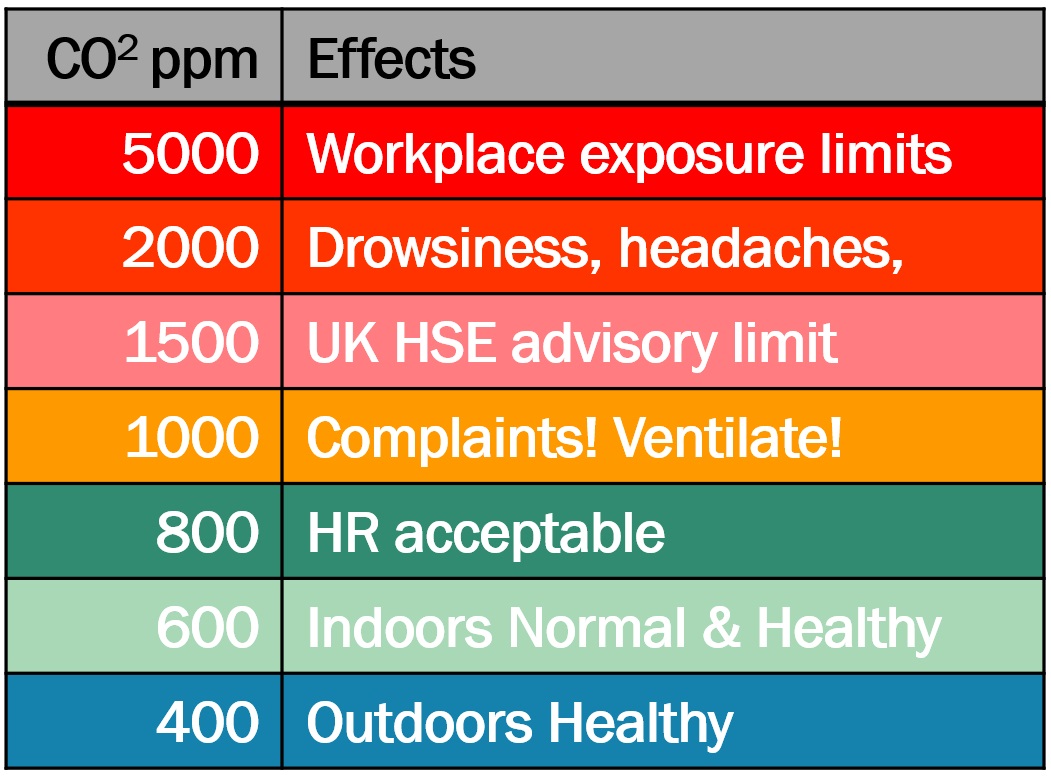
Ventilation and CO2 – Making Measurements that Manage Wellbeing
Are there fights over window openings and thermostat settings? Do customer HR managers ask about office CO2 levels? Can you improve ventilation in your meeting rooms?
Ventilation counteracts the spread of viruses within a room. But how can you know if your building ventilation is adequate?

Why it’s important to measure CO2
CO2 level, as measured in parts-per-million, is our proxy for ventilation performance. Humans breathe out a lot of CO2 and if we see levels significantly increasing, then the ventilation is not coping. Time to turn up the fans, open windows, or remove bodies from the office.
Consider a meeting room of 250 sqft (25sqm) that has no ventilation at all. In just one hour, 4 occupants will breathe out enough CO2 such that the room exceeds the UK’s HSE advisory limit (see table).
CO2 doesn’t tell the whole picture, though. Temperature, humidity, and whether doors and windows are open or closed, contribute further knowledge to help you manage the space and take the right action.
Sensors provide data
This is where sensors come in. Modern sensors, connected to the cloud, are part of emerging IoT and Smart Building developments. Sensors are now being deployed in their millions, forcing costs down.
Equally, the range of what can now be measured is huge – not just for wellbeing but environmental performance, energy cost reporting, air pollution, or sensors for operations measuring anything from desk occupancy to cleaning supplies. Often a single device contains 5 or more sensors.
Once our data gets to the cloud, we can graph it dashboards, set KPIs and alert levels for interventions. We can even drop the data into our management software or occupier apps to communicate building performance.
Sensors produce a timeline of measurements that documents the internal environment. It is this data that tells management when to act or used to reassure customers.
LoRaWan – The New Sensor Network Technology
There is a new generation of sensors is based on a technology called LoRaWan. The sensors need no wires but run for years on simple consumer batteries. LoRa wireless can travel over a kilometre until its signals are picked up by low-cost LoRa gateways. The job of the gateway is to aggregate data from all deployed sensors for on-transmission to the cloud, where it is accessed and manipulated.
Better still, this technology is easily customised to meet specific demands from customers.
You can source “sensors as a service” from a good number of specialist providers. Or, with a little help, you can save cost by building your own, DIY, network.
In the case of CO2 and ventilation, these sensors enable you to build a distinctive message that associates wellbeing with your brand values.
Tony Freeth Informational (TFI) is a consultancy that assists Operators develop their technology base. We are organising sensor pilot studies and welcome new participants. Contact us on info@freeth.info for further information and a copy of the presentation made by Tony Freeth at the Flexsa Roundtable.
7 December 2021
Return to News Page

